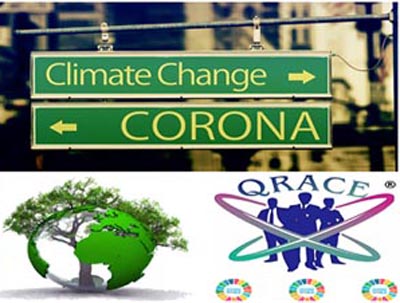‘Global warming is not a conqueror to kneel before – but a challenge to rise too. A challenge we must rise too’ ~ Joe Lieberman
News wave @ New Delhi
Uncontrolled human activity is destabilizing the Earth’s climate and biosphere as shown clearly by innumerable increasingly available unambiguous evidences. This further raise concerns for common public as well as the policy makers who definitely need to more. The COP-21 Paris Agreement limiting greenhouse gas emissions was a major achievement on the road to meeting the threat of climate change in this regard. However, The inherently shared nature of the threat underlines the need for closer and more comprehensive international cooperation to preserve the habitat in which human life has thrived.
William Nordhaus, a noted Nobel Prize laureate for his work on environmental economics, wrote in 1977:“In contemplating the future course of economic growth in the West, scientists are divided between one group crying “wolf” and another which denies that species’ existence. One persistent concern has been that man’s economic activities would reach a scale where the global climate would be significantly affected. Unlike many of the wolf cries, this one, in my opinion, should be taken very seriously.”

Dr Indu Tripathi and her associated research communities and Dr Kumar Gautam, Founder and technological aggregator of Quantum Research and Centre of Excellence (QRACE), New Delhi, India, worked continually towards the development of impactful conservation strategies and to protect and restore #biodiversity, reduce #carbonemissions, invest in women’s livelihoods, and improve access to #cleanwater and #sanitation. A central pillar of this work was Standing Together – our mission is to support some of our longer-term NGO partners through the #COVID19 pandemic.

Intense heat waves in India
A little over four decades later, the wolf is at the door. Looking back, we find reports which clearly mention as we see that the year 2018 has seen more intense heat waves, wildfires, and storms. Seventeen of the 18 warmest years on record have occurred since 2000. This clearly gives visible signs of pressure on the natural environment from human activity that go far beyond these weather-related events. Other key aspects of Earth’s climate and biosphere are under high stress. Rain forests are shrinking leading to biodiversity loss. Polar icecaps are retreating as the ocean warms, and coral reefs are disappearing as the ocean acidifies. Fertilizer runoff injects excessive phosphorous and nitrogen into watersheds, damaging freshwater and coastal ecosystems. The World Wildlife Fund estimates that sixty percent of vertebrate animals have been wiped out since 1970, and insect density is declining in some areas at alarming rates. From another perspective, these planetary disruptions arise because businesses and households do not take account of how their activities harm the environment—in technical language, economic activity often comes with negative externalities.
A key point is that, because climate and biosphere externalities do not respect national boundaries, policies should reflect global, not just local, damages. This makes it unlikely that unilateral national policy actions would be enough-even assuming they could overcome domestic political obstacles. Multilateral cooperation is also essential. The planet is at risk, which means we need much more out-of-the box thinking. India has been under a complete lock down for long to arrest the spread of the COVID-19 pandemic.
This crisis, apart from being a human tragedy, is also expected to hit the economy hard. A closer look into the current scenario, however, reveals that we are facing three converging crises: the on-going COVID-19 pandemic, its immediate impact on the economy and the ever-present threat from climate change. What remains to be seen is how the pandemic and its economic aftermath will affect efforts to address the existing climate crisis. India under the Paris Agreement, has committed to a 40% non-fossil share of cumulative power generation capacity by 2030.
To produce 175 GW of Renewable Energy by 2022
This target is driven by the country’s flagship plan to produce 175 GW of Renewable Energy (RE) by 2022. This target might be affected in the wake of the COVID-19 crisis. The central government has announced a 1.7 trillion stimulus package to support 800 million people in the low-income segment. It also provides the government with a window to consider a low-carbon element in the economic stimulus package. While containing the COVID-19 outbreak is rightfully the primary focus of the central government at this moment, it is also imperative to think about ways to revive the economy in the post-COVID-19 landscape. Low-carbon interventions would not only help in bolstering and sustaining economic growth, but will also provide the much-needed boost in the bigger fight against climate change.
( By Dr. Kumar Gautam, Founder and CEO of QRACE & Dr. Indu Tripathi, Research Director, Energy and Nanotechnology Division of QRACE )
 News Wave Waves of News
News Wave Waves of News








